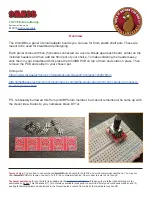
NanoPhotometer
®
NP80/N60/N50/C40
User Guide Version 3.1
69
Growth of bacterial cells typically progresses through a series of consecutive phases including:
lag, log, stationary and decline (see Figure 1). In general, cells should be harvested towards the
end of the log phase using the optical density of the samples to determine when this point has
been reached. Since optical density in the case of OD600 measurements results from light
scattering rather than light absorption, this value varies depending on the type of bacterial cells
in the culture in terms of size and shape. Cells are routinely grown until the absorbance at 600
nm (known as OD 600) reaches approximately 0.4 prior to induction or harvesting. A linear
relationship exists between cell number (density) and OD 600 up to an absorbance value of 0.6,
approximately.
As mentioned above, for turbid samples such as cell cultures, the absorbance measured is due
to light scattering, and not the result of molecular absorption. Since the extent of scattering is
affected by the optics of the system (distance between the cell holder and instrument exit slit,
monochromator optics, slit geometry, etc.), different spectrophotometer types will tend to give
different OD 600 readings for the same turbid sample. Therefore, if results from different
spectrophotometers are to be compared, they must be normalized first using appropriate
calibration curves.
A calibration curve can be constructed by comparing measured OD 600 to expected OD 600.
Expected OD 600 is determined by counting cell number using an alternative technique (for
example microscope slide method) and converting to OD 600 using the rule of thumb that 1 OD
600 = 5 x 10
8
cells/ml for
E. coli
.
The NanoPhotometer
®
comes with a correction factor of 1 as default. To compare OD 600
values between different spectrophotometers, it is necessary to determine the constant
deviation or ratio between the absorbance values for the same sample from each instrument
and use this factor within the setting “correction factor” of your NanoPhotometer
®
Software.
Note:
The use of 10 mm path length disposable cuvettes is recommended for optical density
measurements of cell culture solutions. The amount of cells is reflected in the reading and the
likelihood of fluctuating amount of cells in a drop from sample to sample can be considered as
extremely significant. It is therefore recommended to use cuvettes since the amount of error in a
bigger volume is not as significant. The cuvette measurements provide a bigger average and
therefore more reproducible readings. Also, to prevent the suspension settling too quickly and
giving an OD reading that changes with time, glycerol should be added to the sample.
















































